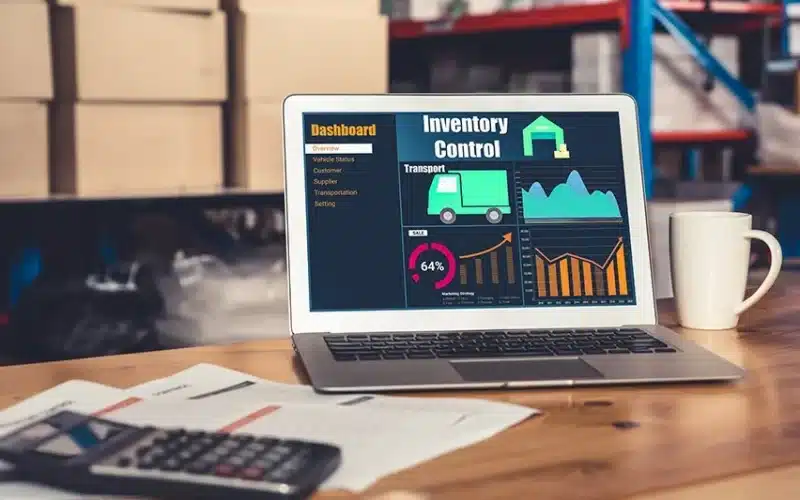The periodic inventory method is a technique of inventory management that allows small enterprises in the retail industry to keep track of their inventory. In the case of an inventory system that operates on a periodic basis, any shifts in stock are only reported on a cyclical basis, most frequently at the end of each month or year. Therefore, organizations that use periodic inventory do so at varying time periods as opposed to keeping track of the loss or gain in merchandise each and every time a financial transaction takes place. In this article, we will discuss the periodic inventory system example, accounting, and the difference between a perpetual inventory system.
To fully understand the periodic inventory system, however, we must first understand what a periodic inventory is.
What Is Periodic Inventory?
Periodic inventory is a stock valuation process that is performed at regular intervals in accounting. At the end of the quarter, businesses physically count their products and use the information to balance their general ledger. The corporations will then use the remaining balance at the beginning of the subsequent term.
Different methods of accounting apply under a perpetual review system and a periodic review system for managing an inventory. At year’s end, the corporation conducts a physical inventory count to determine the amount for periodic inventory. Monthly and quarterly reporting in the middle of the year rely on estimates. When a corporation buys products to resell, accountants don’t update the inventory in the general ledger account. Instead, purchases made with the temporary account are debited. Every new calendar year, a temporary account will have a fresh, empty balance. In addition, at year’s end, the accountant transfers the funds to a separate account.
A contra account in the general ledger is where a business must record any cash or credit disparities that occur as a result of a purchase. The purpose of a contra account, which can be included in financial statements, is to act as a counterbalance to the general ledger. Purchases return and allowances accounts and discounts on purchases are two types of contra accounts. The sum of these two ledgers represents the total amount spent.
In periodic inventory control, shipping costs remain in a separate account from stock. They monitor costs pertaining to Freight In or Transportation In accounts for incoming inventory. Over time, these expenditures will raise the book value of their stock.
How Does Periodic Inventory Work?
The term “inventory” is used to describe the supplies and finished products that a business has on hand and can sell. In the ordinary course of operations, most companies will maintain some level of inventory. Given its importance as an income generator, it ranks highly among a company’s most valuable assets.
Several methods exist for businesses to keep track of their stock levels. The system of taking stock at regular intervals is one example. This system of bookkeeping necessitates a physical count of stock at regular intervals, such as at the end of each quarter or fiscal year. What this means for businesses is that they can keep tabs on their stock levels at the start and conclusion of any given fiscal period. There is no system in place to keep tabs on stock or record sales. Businesses can calculate the cost of goods sold by using the periodic inventory system.
Also, companies with fewer resources may choose periodic inventory counts instead of more frequent counts. In such organizations, counting inventory is typically done manually because there is no need for accounting software to do so. Companies dealing in low-volume goods, such as those dealing in art or automobiles, often adopt this technique.
Taking an inventory at regular intervals is a simple and inexpensive approach to keeping financial records. This is due to the fact that it is not mandatory that it occur regularly. It doesn’t call for expensive programs or even extra help, making it ideal for stores that sell only a few items at a time. However, there are downsides, such as:
- Consequences of human fallibility
- Lack of ability to detect flaws and/or theft
- Possibility of suspending operations for a headcount
What is a Periodic Inventory System
A periodic inventory system is a form of inventory control that works in conjunction with your overall inventory management plan. Periodic systems do not track inventory on a daily basis but rather allow businesses to check their initial inventory and ending stock levels over a set period of time. These systems are designed to track inventory and COGS through physical cycle counts; after physical inventory is completed, the balance in the purchase account is transferred to the inventory account and adjusted to reflect the cost of the ending inventory.
Furthermore, these software applications complement how you currently keep track of inventory. You can use them to collect paper inventory lists, import stock data, and compute numbers like what you’ll need to order more stock and how you’ll need to reconcile the stock you already have for the next accounting period. Accounting can get data and reports electronically. Organizational needs and software features are the primary criteria for making a software purchase.
How Does Periodic Inventory System Work?
For an effective inventory management strategy, businesses should implement a periodic inventory system to ensure that their stock levels are always just right, with no surplus or deficit. It’s possible that an abundance of anything could be detrimental because of waste or the passage of time. Additionally, it causes funds to be held back that may be used for other purposes.
In a similar vein, a shortage can impede productivity and cause mismanagement in the running of a corporation. Therefore, this approach substantially facilitates efficient stock management.
The appropriate division keeps constant tabs on inventory levels across the board, from raw materials to work in progress to final goods. Under a periodic inventory system, the commodities are counted manually, rather than through the use of any kind of automated software or counting system.
However, up-to-date information on inventory levels will be unavailable during the counting process.
To calculate the selling price, we use the following method. But if there is a great deal of inventory and there are many different kinds of the same thing, the work might become laborious and confusing. Counting mistakes, theft, and loss all provide an element of uncertainty.
Calculations in the Periodic Inventory System
As already stated, the difference in inventory value between two physical counts is determined by comparing the opening balances of the two accounts and making the appropriate adjustments for accounting additions and deletions.
The calculation is straightforward:
The quantity of items available for sale is equal to the sum of the initial stock (determined by the most recent physical inventory) and all purchases made between the time of that stock’s depletion and the next physical inventory.
Furthermore, the worth of a company’s inventory is calculated by subtracting the number of items sold in-between physical counts from the cost (or total price) of the things that can be sold. After that, we check the calculated value against the actual count we did. Discrepancies appear as a negative balance in the cost of goods sold statement.
Again, physical inventories take a lot of time and eventually cost money, thus a periodic inventory system is the most popular sort of inventory process adopted by businesses.
Maintaining at least occasional updates to a company’s items available for sale often minimizes any severe concerns in terms of lost goods or lost possibilities for profit, however, discrepancies are more likely to emerge the longer the time between inventories.
Features of Periodic Inventory System
Features of a periodic inventory system include the following:
- Physical count. In this method, raw materials, intermediate products, and completed goods are all physically counted and recorded in order to create an accurate accounting of the company’s stock.
- No real-time monitoring. There is a lag period between counting sessions due to the lack of real-time tracking and the absence of automated software or technology. The latency between an inventory count and its subsequent update can be quite lengthy.
- Techniques used in business. It’s important to remember that not every company can benefit from this strategy. Small businesses, those that employ a consistent set of raw materials, and those that need to count their stock on a regular basis can benefit from this kind of inventory management.
- Calculation of Cost Of Goods Sold. During this step of the process, the COGS is regularly calculated for each case.
- Procedural difficulty. A lack of control and complexity in the accounting periodic inventory system can be attributed to the necessity of using a physical count. If data collection and analysis are inconsistent or ineffective, the results could be misleading.
Therefore, the above features of a periodic inventory system are used by some businesses to ensure efficiency and openness.
What Are the Pros and Cons of the Periodic Inventory System?
To keep tabs on stock levels, a periodic inventory management system performs regular physical counts of all of the items in storage. The benefits of this method are low overhead, straightforward steps, and easy documentation. Here are the top advantages of a periodic inventory system.
#1. Ideal for Start-Ups and Local Shops
Smaller firms with low inventory levels might benefit greatly from the periodic inventory approach. The physical inventory is simple to complete, allowing the temporary cost of goods sold estimates to be made for enterprises with limited resources.
Also, the system’s high degree of inaccuracy makes it useful only for tiny enterprises and a major headache for larger ones. The periodic method is more prone to human error and to the loss or forgetfulness of inventory records because of its manual nature.
The cost of products sold and the ending inventory balance are not available in real-time through the periodic inventory system. As a result, it becomes more difficult to keep track of stock levels.
In order to keep tabs on purchases, sales, and the value of items in real-time, most accounting software employs a perpetual inventory system. In this approach, business owners can account for stock that has been obsolete or scrapped when calculating their COGS.
#2. Reduce Costs
Because it requires such a small amount of material, the periodic inventory system may be quickly set up and result in lower overall expenses. When you use periodic systems, you won’t have to make an expensive investment in software solutions. In fact, strictly speaking, business owners don’t have to invest much of anything at all, other than the time it takes to count their physical inventory in accordance with the time period that has been specified in advance.
#3. Training Restrictions
The procedure of physically counting the inventory may take a lot of time, but it is not a difficult or sophisticated one. At the end of your accounting month, it is necessary for employees to perform a count-up of the leftover stock numbers. When inventory days roll around, you may need to allot more funds for staffing needs, but you won’t need to train personnel to utilize complicated systems to record and track sales on a continuous basis. This aspect is especially advantageous for businesses and fields that experience a high employee turnover rate.
#4. Simple Bookkeeping and Accounting
The periodic inventory utilizes only a few straightforward records, which are as follows: the number of inventory items that are now in stock, also, the number of raw materials that were acquired, and (3) the quantity of inventory that was sold. Due to the simplicity of needing simply to keep track of three variables, keeping records using periodic systems is typically a breeze. This implies that you can start using it immediately to determine the value of your stock.
#5. User-Friendly
Due to the fact that they do not require the use of complicated hardware or software, periodic accounting systems make it simple for companies to begin utilizing the program on the very first day. Because this approach involves very little training and is so extremely simple to put into practice, selecting it as an option for keeping and managing your goods that are available for sale can be a less stressful choice.
Cons of the Periodic Inventory System?
The following is a list of some of the drawbacks of a periodic inventory system that you will want to be aware of:
#1. Inaccuracies
One of the worst things about a periodic inventory system is that it can be extremely inaccurate.. Remember that your physical inventory count is reflected in an updated accounting record at year’s end. This is a fundamental problem in the system. There are occasions when precision just isn’t possible. You can only be fairly confident in the precision. This might not be an issue for some companies, especially if we’re dealing with a very tiny one. However, larger companies will need to be aware that while mistakes aren’t common, they’re also not unheard of when using this approach.
#2. Labor Intensive
If you have a modest stockpile and annual order volume, switching to a periodic inventory system won’t be too difficult. Even an Excel sheet can have information entered into it manually. However, as your company expands, a cyclical method of inventory management may become increasingly difficult to manage. Taking a physical inventory might be a time-consuming process that you really shouldn’t rush through. Finding the time and resources to properly manage a periodic inventory system can be difficult for any organization, but especially for smaller ones. This is the stage where your errors may become noticeable.
#3. Exercising Control
One more thing to keep in mind is that it will be much harder to maintain control over your inventory in the future, so you should prepare for this possibility. It may also become more difficult to determine the extent of the theft problem.
Perpetual and Periodic Inventory System
The perpetual inventory system constantly updates stock levels. Purchasing and selling stock is tracked and accounted for automatically by computerized POS and business asset management systems. It’s a huge upgrade from the old periodic method of stocktaking.
The system of perpetual inventory is very comprehensive. As long as no items have been stolen or damaged, the updated stock count is accurate and readily available. As sales are made, updates are provided to the COGS account as well. Data obtained digitally is uploaded instantly to centralized systems.
There is less involvement on the part of enterprises because of the usage of technology:
- Products are given barcodes to monitor their shelf life and sales performance.
- When combined with a computer system, a point-of-sale (POS) terminal can automatically update stock levels as items are sold.
- All financial transactions, including purchases, COGS, and inventory levels, are recorded in their own ledgers.
Due to the high price of setting up and maintaining such an inventory system, it may be out of reach for some businesses. Compared to the periodic system, this one is significantly less complicated and easy to use. Not only can you keep tabs on things in real-time, but continuous inventory is also more precise than physical counts. With a barcode affixed to every item, businesses can track the flow of inventory with greater precision. Also, read PERPETUAL INVENTORY SYSTEM: Definition and All You Need To Know.
Difference Between Perpetual and Periodic Inventory Systems
The companies that use any of these inventory methods are a key distinction between them. It’s possible that enterprises with modest sales volumes and fewer employees may benefit more from the periodic inventory system. In such situations, stockpiles are usually manageable with hand counts.
Furthermore, businesses with higher sales volumes and more complicated inventory levels may benefit more from the perpetual system. A Perpetual inventory system is commonly used by businesses like supermarkets and drugstores. The technology component of the perpetual inventory system offers various benefits, including the capacity to present all transactions comprehensively at the individual unit level and the ease with which inventory-related problems can be identified.
The two approaches to inventory management also differ significantly in several other key respects, including:
#1. Recording Methods
In a perpetual inventory system, computers and associated software routinely update the company’s books to reflect changes in stock levels and sales. Manual notation is, nevertheless, necessary for a periodic inventory system.
#2. Effort
After the initial setup of a perpetual system’s software and hardware, the company doesn’t have to do much to keep it running. That’s because the entire process takes place online nowadays. A periodic inventory system necessitates physical counts, which can be time-consuming if there are any necessary recounts.
#3. Cost of Goods Sold
In contrast to a perpetual inventory system, which involves consistent postings to the COGS account, periodic systems only do so occasionally. Instead, a single total is arrived at at the end of the counting interval.
#4. Error-Rating Interval
Due to the inherent human element of counting in periodic systems, mistakes are more likely to occur. Assuming there will be no losses due to theft or damage, many businesses opt for everlasting systems.
In addition, the inventory perpetual system enables managers to make informed decisions on the timing of purchases, given that they have complete visibility over the number of commodities held at each of the company’s locations. Theft is one of the types of issues that can be monitored more effectively with improved tracking that is more accurate of inventory levels.
Which Is Better: A Perpetual or Periodic Inventory System?
In most cases, the perpetual system outperforms the periodic method when it comes to managing inventory. That’s because the software used by businesses essentially eliminates the need for human intervention. Barcodes are placed on products, and POS systems monitor their whereabouts as they move through the store. These barcodes provide retailers with a wealth of data, like the average time a product spent on the shelf before being purchased. In addition, permanent systems accurately record the selling and buying prices of products.
What Are the Pros and Cons of Perpetual Inventory System?
Here are the Pros of the perpetual inventory system.
- By monitoring inventory levels in real-time, you may replenish supplies before they run out, saving time and money.
- You can see which products are doing well and which aren’t in real-time thanks to transaction data.
- Inventory management at numerous warehouses is simplified with a centralized system.
- When placing an order for same-day delivery, knowing whether or not an item is in stock is crucial.
- Boosts management’s ability to keep tabs on stock levels
- The process of incorporating an optimizer for either inventory or prices is greatly simplified.
Here are the Cons of the perpetual inventory system.
- A mistake or omission in data entry could lead to inaccurate records.
- The costly initial outlay for software licensing and user education.
- It is time-consuming to record each and every transaction.
Periodic Inventory System Example
Here is a real-life example of a periodic inventory system.
A crucial component of any revenue statement is the cost of goods sold. However, until the physical count is finished, the amount will not be known for the company’s accounting records if it uses a periodic inventory system.
Take, for example, a business whose inventory on January 1 is worth $500,000. Over the course of three months, the firm spends $250,000 on inventory. The March 31 worth of the firm’s inventory is estimated to be $400,000 after a physical count. This is the stock on hand to start the next fiscal period. The first quarter’s cost of goods sold is $350,000 ($500,000 in revenue + $250,000 in expenditures minus $400,000 in revenue).
Due to the time differences, the manager or business owner in charge of monitoring the period inventory must decide if it is financially prudent to set aside time to count inventory on a daily, weekly, monthly, or annual basis.
What Is the Advantage of a Periodic Review System?
There is a wide range of advantages to implementing review cycles. The most obvious advantage is that they assist businesses stay current and in accordance with procurement regulations. Routine performance evaluation systems help find places where costs can be cut or efficiency can be made. Organizations can find places where they can make significant gains in efficiency and effectiveness by carefully assessing their procurement processes and procedures on a regular basis.
However, periodic review systems provide the potential advantages listed above, but they can also aid in developing and sustaining fruitful partnerships with vendors. Regular audits increase the likelihood that a supplier will resolve any problems that arise during the course of the contract. In addition, businesses can show they are serious about maintaining high standards throughout the procurement process by conducting frequent evaluations of supplier performance.
Conclusion
One of the most important things you can do for your company’s bottom line is to settle on an inventory accounting system that works for you. Ultimately, it’s up to you to determine what’s most practical. Let’s pretend you’re the proud proprietor of a tiny business with a limited selection of goods. If that’s the case, you might be able to get by with a less expensive, less frequent inventory system. It’s possible you’ll have to look into other possibilities if that’s not the case.
Periodic Inventory System FAQs
Who Most Likely Uses a Periodic Inventory System?
Small enterprises with a low turnover of inventory per accounting period often employ the periodic inventory system. It’s a common tactic for these businesses, as it’s easy to adopt and doesn’t need any expensive, specific software.
What is periodic inventory taking?
Periodic inventory taking is the physical count of inventory that occurs on a regular basis while employing the periodic inventory system. Even firms that use perpetual inventory should conduct a physical inventory count on a regular basis to allow for shrinkage.
What is the adjusting entry?
The cost of goods sold formula underpins the adjusting input. As a result, the sum of the acquisitions and the merchandise inventory (initial) equals the stock of items for sale.
Similar Articles
- Amortization Schedule, Loans, and Calculations
- STOCK MANAGEMENT: Detailed Guide and Best Practices
- Ordinary Annuity: Formula & How to Calculate
- BEST APPS FOR INVENTORY MANAGEMENT IN 2023
- MERCHANDISING STRATEGY: 7+ Merchandising Strategies to Drive Sales and ROI
- BUSINESS BACKGROUND CHECK: How to Run One & Best Services
- MERCHANT ACCOUNTS: What It Is, Types & Why You Need One






